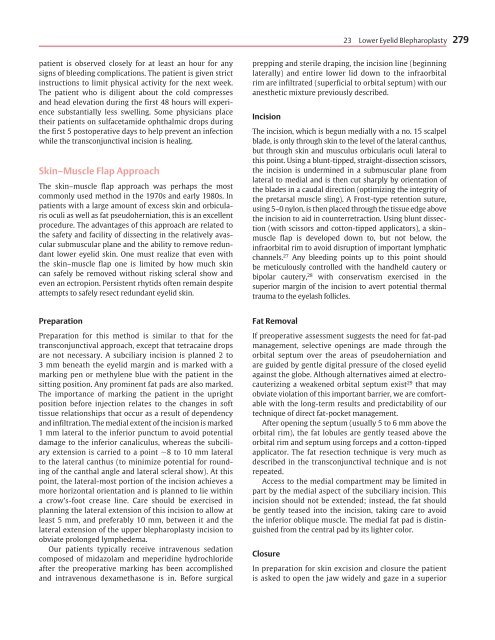23 Lower Eyelid Blepharoplasty - Facial plastic surgeon in San Diego
23 Lower Eyelid Blepharoplasty - Facial plastic surgeon in San Diego
23 Lower Eyelid Blepharoplasty - Facial plastic surgeon in San Diego
You also want an ePaper? Increase the reach of your titles
YUMPU automatically turns print PDFs into web optimized ePapers that Google loves.
<strong>23</strong> <strong>Lower</strong> <strong>Eyelid</strong> <strong>Blepharoplasty</strong> 279patient is observed closely for at least an hour for anysigns of bleed<strong>in</strong>g complications. The patient is given strict<strong>in</strong>structions to limit physical activity for the next week.The patient who is diligent about the cold compressesand head elevation dur<strong>in</strong>g the first 48 hours will experiencesubstantially less swell<strong>in</strong>g. Some physicians placetheir patients on sulfacetamide ophthalmic drops dur<strong>in</strong>gthe first 5 postoperative days to help prevent an <strong>in</strong>fectionwhile the transconjunctival <strong>in</strong>cision is heal<strong>in</strong>g.Sk<strong>in</strong>–Muscle Flap ApproachThe sk<strong>in</strong>–muscle flap approach was perhaps the mostcommonly used method <strong>in</strong> the 1970s and early 1980s. Inpatients with a large amount of excess sk<strong>in</strong> and orbicularisoculi as well as fat pseudoherniation, this is an excellentprocedure. The advantages of this approach are related tothe safety and facility of dissect<strong>in</strong>g <strong>in</strong> the relatively avascularsubmuscular plane and the ability to remove redundantlower eyelid sk<strong>in</strong>. One must realize that even withthe sk<strong>in</strong>–muscle flap one is limited by how much sk<strong>in</strong>can safely be removed without risk<strong>in</strong>g scleral show andeven an ectropion. Persistent rhytids often rema<strong>in</strong> despiteattempts to safely resect redundant eyelid sk<strong>in</strong>.prepp<strong>in</strong>g and sterile drap<strong>in</strong>g, the <strong>in</strong>cision l<strong>in</strong>e (beg<strong>in</strong>n<strong>in</strong>glaterally) and entire lower lid down to the <strong>in</strong>fraorbitalrim are <strong>in</strong>filtrated (superficial to orbital septum) with ouranesthetic mixture previously described.IncisionThe <strong>in</strong>cision, which is begun medially with a no. 15 scalpelblade, is only through sk<strong>in</strong> to the level of the lateral canthus,but through sk<strong>in</strong> and musculus orbicularis oculi lateral tothis po<strong>in</strong>t. Us<strong>in</strong>g a blunt-tipped, straight-dissection scissors,the <strong>in</strong>cision is underm<strong>in</strong>ed <strong>in</strong> a submuscular plane fromlateral to medial and is then cut sharply by orientation ofthe blades <strong>in</strong> a caudal direction (optimiz<strong>in</strong>g the <strong>in</strong>tegrity ofthe pretarsal muscle sl<strong>in</strong>g). A Frost-type retention suture,us<strong>in</strong>g 5–0 nylon, is then placed through the tissue edge abovethe <strong>in</strong>cision to aid <strong>in</strong> counterretraction. Us<strong>in</strong>g blunt dissection(with scissors and cotton-tipped applicators), a sk<strong>in</strong>–muscle flap is developed down to, but not below, the<strong>in</strong>fraorbital rim to avoid disruption of important lymphaticchannels. 27 Any bleed<strong>in</strong>g po<strong>in</strong>ts up to this po<strong>in</strong>t shouldbe meticulously controlled with the handheld cautery orbipolar cautery, 28 with conservatism exercised <strong>in</strong> thesuperior marg<strong>in</strong> of the <strong>in</strong>cision to avert potential thermaltrauma to the eyelash follicles.PreparationPreparation for this method is similar to that for thetransconjunctival approach, except that tetraca<strong>in</strong>e dropsare not necessary. A subciliary <strong>in</strong>cision is planned 2 to3 mm beneath the eyelid marg<strong>in</strong> and is marked with amark<strong>in</strong>g pen or methylene blue with the patient <strong>in</strong> thesitt<strong>in</strong>g position. Any prom<strong>in</strong>ent fat pads are also marked.The importance of mark<strong>in</strong>g the patient <strong>in</strong> the uprightposition before <strong>in</strong>jection relates to the changes <strong>in</strong> softtissue relationships that occur as a result of dependencyand <strong>in</strong>filtration. The medial extent of the <strong>in</strong>cision is marked1 mm lateral to the <strong>in</strong>ferior punctum to avoid potentialdamage to the <strong>in</strong>ferior canaliculus, whereas the subciliaryextension is carried to a po<strong>in</strong>t 8 to 10 mm lateralto the lateral canthus (to m<strong>in</strong>imize potential for round<strong>in</strong>gof the canthal angle and lateral scleral show). At thispo<strong>in</strong>t, the lateral-most portion of the <strong>in</strong>cision achieves amore horizontal orientation and is planned to lie with<strong>in</strong>a crow’s-foot crease l<strong>in</strong>e. Care should be exercised <strong>in</strong>plann<strong>in</strong>g the lateral extension of this <strong>in</strong>cision to allow atleast 5 mm, and preferably 10 mm, between it and thelateral extension of the upper blepharoplasty <strong>in</strong>cision toobviate prolonged lymphedema.Our patients typically receive <strong>in</strong>travenous sedationcomposed of midazolam and meperid<strong>in</strong>e hydrochlorideafter the preoperative mark<strong>in</strong>g has been accomplishedand <strong>in</strong>travenous dexamethasone is <strong>in</strong>. Before surgicalFat RemovalIf preoperative assessment suggests the need for fat-padmanagement, selective open<strong>in</strong>gs are made through theorbital septum over the areas of pseudoherniation andare guided by gentle digital pressure of the closed eyelidaga<strong>in</strong>st the globe. Although alternatives aimed at electrocauteriz<strong>in</strong>ga weakened orbital septum exist 29 that mayobviate violation of this important barrier, we are comfortablewith the long-term results and predictability of ourtechnique of direct fat-pocket management.After open<strong>in</strong>g the septum (usually 5 to 6 mm above theorbital rim), the fat lobules are gently teased above theorbital rim and septum us<strong>in</strong>g forceps and a cotton-tippedapplicator. The fat resection technique is very much asdescribed <strong>in</strong> the transconjunctival technique and is notrepeated.Access to the medial compartment may be limited <strong>in</strong>part by the medial aspect of the subciliary <strong>in</strong>cision. This<strong>in</strong>cision should not be extended; <strong>in</strong>stead, the fat shouldbe gently teased <strong>in</strong>to the <strong>in</strong>cision, tak<strong>in</strong>g care to avoidthe <strong>in</strong>ferior oblique muscle. The medial fat pad is dist<strong>in</strong>guishedfrom the central pad by its lighter color.ClosureIn preparation for sk<strong>in</strong> excision and closure the patientis asked to open the jaw widely and gaze <strong>in</strong> a superior


